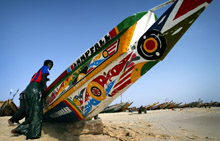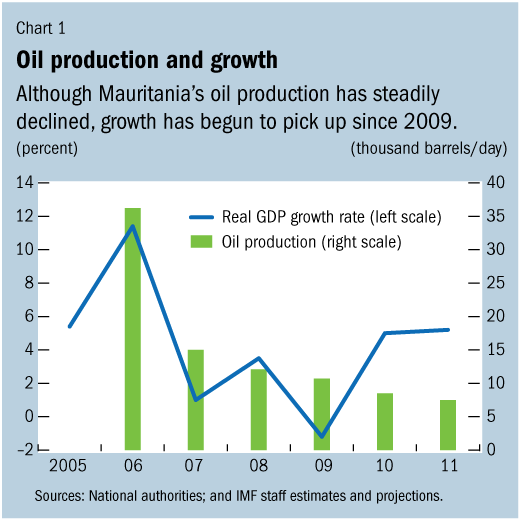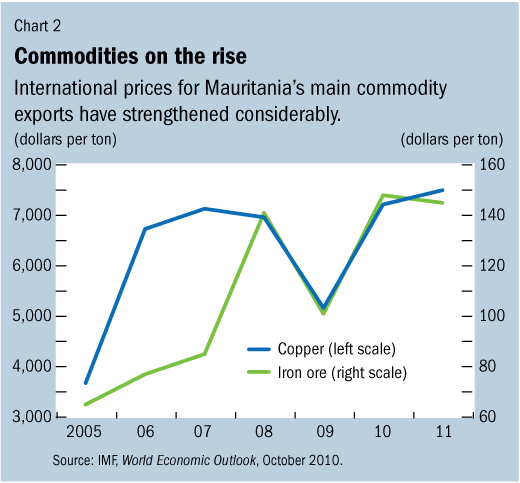
Typical street scene in Santa Ana, El Salvador. (Photo: iStock)
IMF Survey: Mauritania Shows Signs of Recovery After Series of Setbacks
November 22, 2010
- Return of political stability was first step toward macroeconomic stability
- Rising prices of main commodity exports helping recovery
- Medium-term goal is to diversify economy to reduce vulnerability to shocks
Mauritania is witnessing a rebound in economic growth after a series of adverse shocks—including the food and fuel crisis, domestic political difficulties, and the global economic crisis—took a toll in recent years.

Fisherman near Nouakchott: Fishing and mining are key sources of exports for the economy, which the government seeks to diversify (photo: Finbarr O’Reilly/Reuters)
LOW-INCOME COUNTRIES
In a vote of confidence for the country’s economic reforms, the IMF has just completed the first review of the country’s $118 million arrangement under the Extended Credit Facility (ECF), paving the way for an immediate disbursement of $17 million. The three-year loan, approved in March 2010, marked the resumption of IMF financial assistance to Mauritania after a 19-month hiatus.
We estimate that the economy will grow by 5 percent this year and just over 5 percent in 2011. This growth reflects the authorities’ strong reform agenda, the rebound in prices of Mauritania’s main exports, and the normalization of relations with the international community.
Multiple shocks
The North African country, one of the continent’s poorest, had high hopes for a dramatic change of fortune when oil was discovered off its shores in 2001. Production in Chinguetti, the main oil field, started in 2006 and immediately ran into major technical difficulties, which led output to fall from close to 75,000 barrels per day (bpd) in early 2006 to 23,000 by end-2006. Since then, oil production has steadily declined, with output projected to be as low as 7,000 bpd in 2011 (see Chart 1).

On the back of the unexpected and prolonged fall in oil output, Mauritania was hit hard by the fuel and food crisis and the global recession in 2008–09. In addition, an August 2008 military coup—the second in the past five years—led to a domestic political crisis and the suspension of assistance from many bilateral and multilateral donors, including the IMF.
The combination of these adverse shocks had a profound impact on this desert nation of just over 3 million people. Non-oil real GDP contracted by 1.1 percent in 2009, down from 4.1 percent in 2008. With the decline in oil production, total GDP also fell by 1.2 percent. The fiscal deficit widened and the external position deteriorated sharply, with external reserves dropping below 1.5 months of imports of goods and services. As a result, progress on poverty reduction slowed.
Turning point
The country’s internationally recognized presidential election of July 2009, won by Mohamed Ould Abdel Aziz, marked the return to a constitutional order. This step enabled the international community to resume normal relations with Mauritania, signaling a turning point for the country.
The IMF was one of the first agencies to respond, resuming its provision of technical assistance in September 2009 and starting discussions with the Mauritanian authorities on a new program of economic reforms supported by a three-year ECF arrangement, which was approved by the IMF’s Executive Board in March 2010.
Today, the Mauritanian authorities have made good progress in reestablishing macroeconomic stability. Inflation is projected to remain in the single digits, while rapid credit growth, a strong pickup in exports, and a rebound in industrial production point to robust growth in the non-oil sector. Non-oil real GDP is expected to grow by 5.6 percent in 2010 and 5.5 percent in 2011, supported by strong activity in the agriculture, mining, and construction sectors. Thanks to higher prices and production levels of Mauritania’s iron ore, gold, and copper exports, the fiscal and external positions could improve (see Chart 2).

Solid reform agenda
The authorities’ economic reform agenda focuses on
• achieving fiscal consolidation while, at the same time, creating more room for higher social and infrastructure spending;
• further enhancing the monetary policy framework to maintain low inflation and rebuild official reserves;
• deepening financial intermediation and improving the business environment to support broad-based private sector–led-growth; and
• strengthening social protection and safety nets.
In a move to signal a strong commitment to the reform agenda, Mauritania’s central bank lowered its policy rate from 12 to 9 percent in November 2009 and restored the foreign exchange auction system in mid-December 2009. (The system was suspended in late 2008 following an acute shortage of foreign currency.)
Much to be done
As with many low-income countries, the main goal is to achieve high and sustainable growth in order to boost employment and reduce poverty. Almost one out of two Mauritanians lives below the poverty line, and a large segment of the population remains subject to food insecurity.
Progress has been made in many areas, but private investment is still low, in part because limited infrastructure and an unfavorable business climate continue to hamper economic growth. And diversifying the economy is essential to reducing Mauritania’s vulnerability to external shocks, since the mining sector represents nearly 75 percent of exports but less than 3 percent of employment. Meeting these challenges will require sound macroeconomic policies and the steady implementation of structural reforms.
The IMF and others continue to deliver technical assistance in a number of areas—public financial management, central bank operations, microfinance, external and domestic debt, and macroeconomic data management. Other international financial institutions and bilateral donors have also shown support for the newly stable country: at a round table in Brussels last June, donors pledged to provide assistance in the amount of about $3.2 billion over 2011–15.
Paul Jenkins (IMF Strategy, Policy, and Review Department), Reinout De Bock, and Binta Terrier (both of the IMF’s Middle East and Central Asia Department) also contributed to this article.







